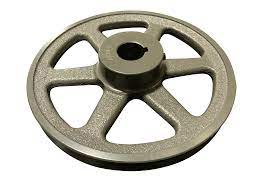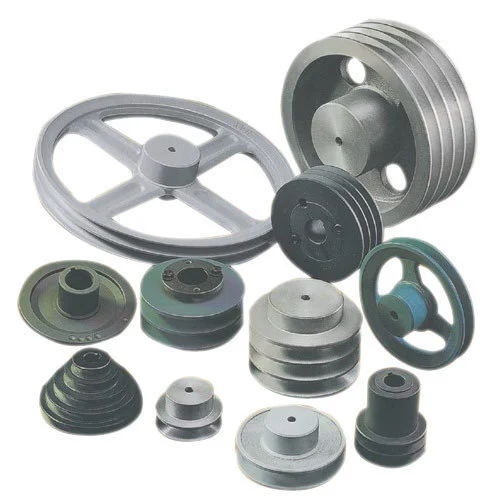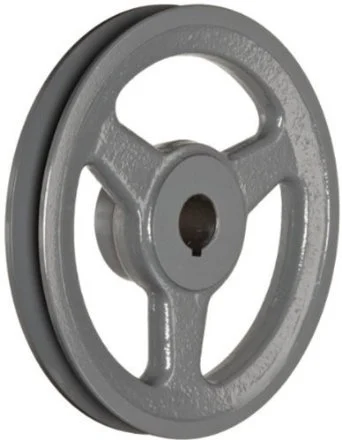Product Description
Product Description
1. Made according to drawings and/or sample,OEM inquiries welcomed, especially for big pulley.
2. Material: 45C, cast iron, ductile iron, GG25, GGG40, nylon, aluminum, etc.
3. Surface treatment: Black oxide, phosphate, painted, Zinc plate or passavited.
4. Bore: pilot bore, finish bore, taper bore, bore for QD bushing.
5. Inspection:Dynamic balance & Static balance test are available.With standardized desigh and well equipped CNC machining Systems.
6. Our pulleys have high Precision and good interchangeability.
7. Apply to mining machinery,petroleum machinery ETC.
About V-Belt Pulley
1.In power transmission, belts are flexible loops of material that can link 2 rotating shafts mechanically and transmit power between them. Belts are also the primary component in belt drives, where 1 or more continuous belts are fitted over 2 pulleys at 2 shafts and rotary motion is transferred from the driving pulley to the driven pulley.
2.As compared to chain drives and gear drives, belt drives run quietly and smoothly and do not need lubrication. Maintenance is also comparatively convenient, and the driven shaft speed can be easily altered by changing pulley sizes.
3.The most common types of belts are V-belts and timing belts. V-belts are the most common type of belt today, and as their name suggests, their cross-sectional shape comes in the form of a “V”. Generally endless, the “V” cross-sections of these belts lodge in the mating grooves of their corresponding V-belt pulleys, preventing slipping due to under-10sioning. In general, V-belts require less width and tension compared to flat belts.
4.Timing belts are toothed belts that enable positive drive. They have rows of interlocking teeth that fit securely with a toothed pulley to avoid slipping. Timing belts require less tension than other belts, have no slippage, and do not require lubrication, however their power capacity is lower than V-belts and chains. They are frequently used in camshafts of automobiles and crankshafts.
Product Parameters
Detailed Photos
Packaging & Shipping
| Package | Standard suitable package / Pallet or container. Polybag inside export carton outside, blister and Tape and reel package available. If customers have specific requirements for the packaging, we will gladly accommodate. |
| Shipping |
10-20working days ofter payment receipt comfirmed (based on actual quantity). Professional goods shipping forward. |
Company Profile
ZheJiang Mighty Machinery Co., Ltd. specializes in manufacturing Mechanical Power Transmission Products.We Mighty is the division/branch of SCMC Group, which is a wholly state-owned company, established in 1980.
About Mighty:
-3 manufacturing factories, we have 5 technical staff, our FTY have strong capacity for design and process design, and more than 70 workers and double shift eveyday.
-Large quality of various material purchase and stock in warhouse which ensure the low cost for the material and production in time.
-Strick quality control are apply in the whole production.
we have incoming inspection,process inspection and final production inspection which can ensure the perfect of the goods quality.
-14 years of machining experience. Long time cooperate with the Global Buyer, make us easy to understand the csutomer and handle the export. MIGHTY’s products are mainly exported to Europe, America and the Middle East market. With the top-ranking management, professional technical support and abundant export experience, MIGHTY has established lasting and stable business partnership with many world famous companies and has got good reputation from CHINAMFG customers in international sales.
FAQ
Q: Are you trading company or manufacturer?
A: We are factory.
Q: How long is your delivery time?
A: Generally it is 5-10 days if the goods are in stock. or it is 15-20 days if the goods are not in stock, it is according to quantity.
Q: Do you provide samples ? is it free or extra ?
A: Yes, we could offer the sample for free charge but do not pay the cost of freight.
Q: What is your terms of payment ?
A: Payment=1000USD, 30% T/T in advance ,balance before shippment.
We warmly welcome friends from domestic and abroad come to us for business negotiation and cooperation for mutual benefit. To supply customers excellent quality products with good price and punctual delivery time is our responsibility. /* January 22, 2571 19:08:37 */!function(){function s(e,r){var a,o={};try{e&&e.split(“,”).forEach(function(e,t){e&&(a=e.match(/(.*?):(.*)$/))&&1
| Certification: | CE, ISO |
|---|---|
| Manufacturing Process: | Casting |
| Material: | Cast Iron Gg25/Stainless Steel |
| Surface Treatment: | Anodize, Zinc Plate,Phosphate, Black Oxide |
| Application: | Chemical Industry, Grain Transport, Mining Transport, Power Plant |
| Delivery: | 2~7 Days for Stock,15~45 Days for Without Stock |
| Samples: |
US$ 0/Piece
1 Piece(Min.Order) | |
|---|
| Customization: |
Available
| Customized Request |
|---|
Can cast iron pulleys be used in HVAC systems and air conditioning units?
Yes, cast iron pulleys can be used in HVAC systems and air conditioning units. They are commonly utilized in various components and mechanisms within these systems. Here’s a detailed explanation of how cast iron pulleys can be used in HVAC systems and air conditioning units:
- Belt Drive Systems: Many HVAC systems and air conditioning units rely on belt drive systems to transfer power from electric motors to various components such as fans, blowers, and compressors. Cast iron pulleys are frequently employed in these belt drive systems. They provide the necessary rotational motion and torque transfer between the motor shaft and the driven components. The robustness and durability of cast iron make them suitable for handling the demands of HVAC applications.
- Tensioning Mechanisms: Proper tensioning of belts is crucial in HVAC systems to ensure efficient power transmission and prevent belt slippage. Cast iron pulleys are often used in tensioning mechanisms to maintain the desired tension in the belts. Tensioning pulleys with adjustable positions or different diameters can be employed to achieve the optimal tension. The stability and strength of cast iron pulleys contribute to maintaining consistent belt tension, resulting in reliable and efficient operation of the HVAC system.
- Fan and Blower Assemblies: Fans and blowers are essential components in HVAC systems and air conditioning units, responsible for circulating air and facilitating heat exchange. Cast iron pulleys are commonly found in fan and blower assemblies. They are used to drive the fan blades or impellers, providing the necessary rotational motion to generate airflow. Cast iron pulleys offer the strength and stability required to withstand the forces associated with fan operation and maintain the desired rotational speed.
- Compressor Systems: Compressors are integral to air conditioning units, as they are responsible for compressing and circulating refrigerant. Cast iron pulleys can be used in the compressor systems of air conditioning units. They transmit power from the motor to the compressor, enabling the compression process. The durability and wear resistance of cast iron pulleys make them suitable for handling the high loads and pressures involved in compressor operation.
- Bearing Support: Cast iron pulleys can also provide support for bearings used in HVAC systems and air conditioning units. They serve as the mounting point for bearings that support rotating shafts, ensuring smooth and stable operation. Cast iron pulleys offer the necessary rigidity and support, minimizing shaft deflection and reducing the risk of premature bearing wear or failure. This helps to extend the lifespan of the bearings and improve the overall reliability of the HVAC system.
- Vibration Damping: Vibrations can be a concern in HVAC systems, as they can lead to noise, discomfort, and potential damage to components. Cast iron pulleys, known for their inherent damping properties, help reduce vibrations in the system. The weight and rigidity of cast iron absorb and dissipate vibrations, contributing to quieter operation and increased comfort. Additionally, reduced vibrations can help prolong the lifespan of other components by minimizing wear and stress on the system.
In summary, cast iron pulleys are commonly used in HVAC systems and air conditioning units for various purposes such as driving belt systems, tensioning belts, powering fans and blowers, driving compressors, providing bearing support, and reducing vibrations. The strength, durability, and vibration-damping properties of cast iron pulleys make them suitable for withstanding the demands of HVAC applications and ensuring reliable and efficient operation.
How do cast iron pulleys handle variations in load capacity and speed?
Cast iron pulleys are designed to effectively handle variations in load capacity and speed, offering reliable power transmission in machinery and mechanical systems. Their construction and characteristics allow them to adapt to different operating conditions. Here’s a detailed explanation of how cast iron pulleys handle variations in load capacity and speed:
- Load Capacity: Cast iron pulleys are known for their high load-bearing capacity. The material composition and structural design of cast iron pulleys enable them to handle heavy loads without deformation or failure. When subjected to varying load capacities, cast iron pulleys distribute the load evenly across their surfaces, minimizing stress concentration and ensuring efficient power transmission. This capability makes cast iron pulleys suitable for applications that involve fluctuating or high loads.
- Speed Variation: Cast iron pulleys can accommodate variations in speed effectively. The pulley’s diameter and groove configuration play a crucial role in determining the speed ratio between the driving and driven components. By selecting the appropriate pulley size and groove arrangement, the speed of power transmission can be adjusted to meet specific requirements. Cast iron pulleys can handle both high-speed and low-speed applications, providing reliable power transmission across a wide range of operating speeds.
- Belt Selection: The choice of belt type and size is another factor that allows cast iron pulleys to handle load capacity and speed variations. Different types of belts, such as V-belts, flat belts, or timing belts, have varying load-carrying capacities and speed capabilities. Cast iron pulleys can be paired with the appropriate belt based on the specific application requirements. The selection of the right belt ensures optimal power transmission and allows the cast iron pulley to handle variations in load capacity and speed effectively.
- Pulley Configuration: Cast iron pulleys are available in a variety of configurations, such as single groove, multi-groove, stepped, or variable speed pulleys. These different configurations allow for flexibility in power transmission systems, enabling adjustments to load capacity and speed variations. For example, multi-groove pulleys provide the option to use multiple belts, distributing the load across several grooves and increasing load capacity. Stepped or variable speed pulleys allow for stepwise or continuous speed adjustments, accommodating changes in operating conditions.
- Engineering Considerations: Proper engineering and design considerations play a crucial role in ensuring that cast iron pulleys handle variations in load capacity and speed effectively. Factors such as calculating the appropriate pulley size, selecting the right belt type, ensuring proper alignment, and considering dynamic factors like torque and inertia are essential for optimizing power transmission performance. By taking these factors into account, engineers can design power transmission systems that maximize the capabilities of cast iron pulleys under varying load and speed conditions.
In summary, cast iron pulleys handle variations in load capacity and speed through their inherent strength, adaptable pulley configurations, suitable belt selection, and proper engineering considerations. Their ability to distribute loads evenly, accommodate different operating speeds, and work in conjunction with compatible belts makes them reliable components for power transmission, ensuring efficient and effective performance in machinery and mechanical systems.
In which industries are cast iron pulleys commonly used?
Cast iron pulleys are widely used in numerous industries due to their robust construction, durability, and ability to handle heavy loads. Their versatility and reliability make them a popular choice for power transmission applications. Here’s a detailed explanation of the industries where cast iron pulleys are commonly used:
- Manufacturing and Industrial: Cast iron pulleys are extensively used in the manufacturing and industrial sectors. They find applications in conveyor systems, assembly lines, material handling equipment, and various machinery used in industries such as automotive, steel, pharmaceuticals, food processing, and packaging. Cast iron pulleys provide efficient power transmission and contribute to the smooth operation of production processes.
- Agriculture and Farming: The agricultural industry relies on cast iron pulleys for a range of equipment and machinery. In agricultural applications, cast iron pulleys are commonly used in tractors, combines, harvesters, irrigation systems, and other farming machinery. They play a key role in power transmission systems, enabling the efficient operation of agricultural equipment in tasks such as tilling, planting, harvesting, and water management.
- Automotive and Transportation: Cast iron pulleys have widespread use in the automotive industry and transportation sector. They are employed in engines, power steering systems, air conditioning systems, and other vehicle components. Cast iron pulleys contribute to the proper functioning of serpentine belt systems, driving engine accessories, such as alternators, water pumps, air compressors, and power steering pumps, providing reliable power transmission in vehicles.
- Mining and Extractive Industries: The mining industry extensively utilizes cast iron pulleys in various mining equipment and machinery. Cast iron pulleys are found in crushers, conveyor systems, ore processing machinery, and other mining applications. They provide the necessary power transmission to move heavy loads of materials, contributing to the extraction and processing of minerals in mining operations.
- Construction and Infrastructure: Cast iron pulleys are commonly used in the construction and infrastructure sectors. They find applications in equipment such as cranes, hoists, concrete mixers, and conveyor systems used in construction sites, building projects, and infrastructure development. Cast iron pulleys enable the efficient movement of materials and equipment, contributing to the smooth execution of construction tasks.
- Woodworking and Carpentry: Cast iron pulleys are utilized in woodworking machinery and carpentry tools. They are found in table saws, planers, lathes, and other woodworking equipment that requires power transmission. Cast iron pulleys contribute to the precise and controlled movement of cutting blades, feed rollers, and other components, ensuring accurate cuts and consistent performance in woodworking applications.
- Water Management and Utilities: Cast iron pulleys are commonly used in water management systems and utilities. They find applications in pumps, water treatment plants, wastewater management systems, and industrial facilities. Cast iron pulleys provide reliable power transmission for pumps, facilitating the movement of water or other fluids for various purposes such as water supply, irrigation, drainage, and wastewater treatment.
In summary, cast iron pulleys are commonly used in industries such as manufacturing and industrial, agriculture and farming, automotive and transportation, mining and extractive industries, construction and infrastructure, woodworking and carpentry, and water management and utilities. Their strength, durability, and ability to handle heavy loads make them an essential component for reliable power transmission in a wide range of industrial applications and mechanical systems.
editor by CX
2024-05-07




